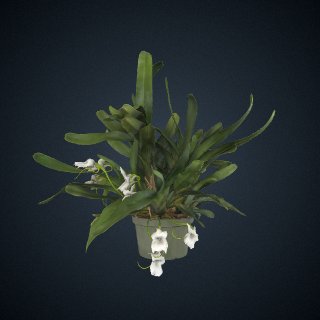Object Details
- Description
- This Madagascan orchid grows on boulders littered with rich pockets of nutritious leaf matter. Madelaine’s Angreacum has large white flowers with a delicious scent that becomes stronger at night. It also has an interesting story. Although the orchid is listed as being discovered by the French naturalist H. Perrier, he made a note at the time that it should be called Madelaine’s Angreacum, for the lovely woman who discovered it on a mountain and then cultivated it, Madelaine Drouhard. Two years later, they were married. Whether Perrier “borrowed” Drouhard’s work, or they were a botanical team is a mystery of history.
- Provenance
- From a cultivated plant not of known wild origin
- Range
- Madagascar
- Habitat
- Near quartzite boulders in leaf litter; 800-2000m
- Topic
- Orchids
- Living Collections
- See more items in
- Smithsonian Gardens Orchid Collection
- Data Source
- Smithsonian Gardens
- Accession Number
- 2011-1992A
- Restrictions & Rights
- CC0
- Common Name
- Madelaine's Angraecum
- The Snow-White Angraecum
- Group
- [vascular plants]
- Class
- Equisetopsida
- Subclass
- Magnoliidae
- Superorder
- Lilianae
- Order
- Asparagales
- Family
- Orchidaceae
- Subfamily
- Epidendroideae
- Genus
- Angraecum
- Species
- magdalenae
- Life Form
- Lithophytic
- Bloom Characteristics
- Short inflorescence is .8-1.2" long with 1-5 large, fleshy, white flowers. Flowers are 3-4" across and can last 4-6 weeks.
- Fragrance
- Spicy, jasmine; at night
- Record ID
- ofeo-sg_2011-1992A
- Metadata Usage
- CC0
Related Object Groups
This image is in the public domain (free of copyright restrictions). You can copy, modify, and distribute this work without contacting the Smithsonian. For more information, visit the Smithsonian's Open Access page.
We also suggest that users:
- Give attribution to the Smithsonian.
- Contribute back any modifications or improvements.
- Do not mislead others or misrepresent the datasets or its sources.
- Be responsible.
International media Interoperability Framework
IIIF provides researchers rich metadata and media viewing options for comparison of works across cultural heritage collections. Visit the IIIF page to learn more.

3D Model

